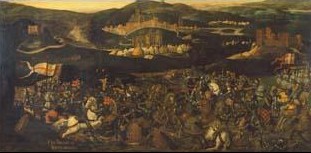 On this day in history, the 16th August 1513, the Battle of Spurs took place at Guinegate (Enguinegatte) in France. It was a battle between the English, backed by Imperial troops, and the French and is called “the Battle of the Spurs” because the French knights, taken by surprise and realising that they were outnumbered and outmanoeuvred, fled on horseback, their spurs glinting in the sunlight. As J J Scarisbrick points out:-
On this day in history, the 16th August 1513, the Battle of Spurs took place at Guinegate (Enguinegatte) in France. It was a battle between the English, backed by Imperial troops, and the French and is called “the Battle of the Spurs” because the French knights, taken by surprise and realising that they were outnumbered and outmanoeuvred, fled on horseback, their spurs glinting in the sunlight. As J J Scarisbrick points out:-
“There was no pitched battle – only a hurtling gallop across the fields at Guingates”1
but the fact that six standards were left behind and a duke, marquis and the vice-admiral of France were captured “was enough to give the skirmish the aura of an heroic victory – the so-called Battle of the Spurs – and to allow Henry to describe it in grandiose terms.”2
We have a record of Henry VIII’s letter to Margaret of Savoy on the 17th August 1513, in which he reports that:-
“Yesterday morning, after he and the Emperor had crossed the Lys, which passes before Terouenne, towards Guinegate, news came that all the French horse at Blangy were moving, some toward Guinegate, the others to the place where Lord Talbot was stationed before Terouenne to cut off supplies. A skirmish took place and there were taken on his side 44 men and 22 wounded. The French, thinking that the English were still beyond the Lys, considered they would not be in time to prevent them revictualling the town. The English horse however passed by Guinegate and confronted the French, who were three times their number. Several encounters took place and men were wounded on both sides. After this, in the Emperor’s company, advanced straight against the French, causing the artillery to be fired at them, whereupon they immediately began to retire, and were pursued for 10 leagues without great loss to the English. Nine or ten standards were taken and many prisoners, among whom are the Duke of Longueville, Marquis of Rothelin, Count de Dunois, Messire René de Clermont, Viceadmiral of France, and others whose names are enclosed. It is said that Lord Fiennes is killed, for his horse is in the English camp. The standard bearer of the “grand escuyer de France,” Count Galeace de St. Severin, is also taken. De La Palice is said to be either wounded or killed. The Emperor has been as kind to him as if he were his real father. At the camp at Gynegate before Terouenne, 17 Aug. 1513.”3
According to Scarisbrick, Henry VIII actually missed the battle, if it can really be called that, because he was laying siege to the nearby town of Therouanne, a town which soon surrendered to the English and Imperial forces along with the town of Tournai. Other sources have Henry present but behind the front line, rather than in the middle of the action as he is portrayed in the painting.
Notes and Sources
- Henry VIII, J J Scarisbrick, Methuen Paperbacks, p58-59
- Ibid., p60
- LP i.2170